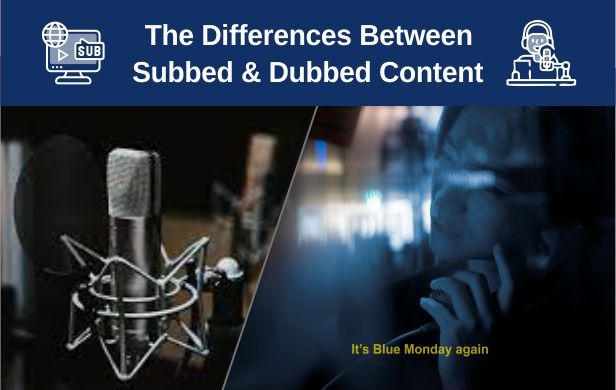
Streaming platforms all over the world have seen a surge in subscribers during and post the COVID-19 pandemic for multilingual content. With the rise of global cinema and easy accessibility to streaming services, the question that arises now is the difference between subtitling and dubbing.
Slide 1 -
Reasons you
One of the best ways to enjoy and appreciate foreign language content is through subtitles or dubbing. This allows streaming platforms to deliver foreign films, documentaries, and series to a global audience. The added benefit is an increase in the awareness about various cultures and that different rarer languages and cultures gain an audience that would not have been possible due to a language gap.
If you enjoy culturally diverse content, the next question is - what is the most effective way to convey content to a foreign language audience?
This is where the concepts of subtitling and dubbing come into play!
Subtitling and dubbing are two major types of screen translation services used in the global broadcast of foreign media.
In subtitling, the dialogue, the transcript, or the screenplay is translated into another language in text format. The text is then superimposed over the film or video. Subtitles are often displayed on the lower part of the screen.
Dubbing involves employing voice actors as dubbers to replace the original actors’ dialogues with voice actors who speak a different language. The newly-created audio is then mixed with the original track of the content to complete the soundtrack.
Understanding the differences between subtitling and dubbing can help you identify a screen translation service that is aligned with your requirements and preferences.
Here are the key differences between subtitles and dubbing:
The methods of creating subbed and dubbed content are very different. Subtitling requires manual transcribing of audio in the original and/or target language. Each of the captions will need to be manually translated ensuring that the cultural context and accuracy are maintained in the new language.
Dubbing, on the other hand, is a complex process that requires multiple experts working simultaneously. The first part of the process involves the creation of a script. Specialized and experienced language experts will translate the dialogue into a different language, the voice actors will help in recording the translation in audio format and media specialists will ensure that the dubbed material is synchronized with the original script. This makes the process significantly more challenging than subtitling.
One of the most enjoyed benefits of subbed content is that it preserves the original audio of the film. The audio quality of the film remains intact during the process of subtitling. This allows you to listen to and appreciate the original language while understanding what is being conveyed in subtitles displayed on the bottom of the screen.
Dubbed content, however, is different. In dubbing, the original soundtrack of the content is completely removed and replaced with a new voice track. The new voice track is merged with the original soundtrack to create a film that is suited to the adapted country.
With dubbing, a significant amount of effort is invested in ensuring that the dialogues are synchronized with the lip movements of the actors in the original video.
Finally, concerning the cost of production, subtitling is considered 10 times cheaper than dubbing. The process of subtitling is also significantly faster, and the benefits include allowing an audience to appreciate a foreign language.
Dubbing, on the other hand, requires a multidisciplinary approach that includes a team of translators, media experts and voice talent professionals. The associated cost of production is therefore significantly higher.
There are several reasons why subbed content is popular amongst the different types of visual media consumed.
With subtitling, you can easily listen to the original voices of the actors in the video. This contributes significantly to the overall viewing experience.
The content translation is carried out by professional subtitlers who ensure that cultural adaptation is employed where exact equivalence across different languages is not possible.
Another advantage of subbed material is that it is the best option for viewers who are hard of hearing or who have difficulty comprehending spoken dialogue. With the content available in written form, the video can be enjoyed regardless.
One of the key advantages of dubbed content is that the audience can consume the video or the film in their own language. This helps make the material a lot more immersive.
Dubbing is also among the most preferred translation strategies for animation. This aids minimal discrepancy between mouth movements and speech..
Dubbed material also significantly contributes to familiarity, since there is no adjustment required to another language. This contributes to the understanding of the plot and material better.
At Language Services Bureau, we recognize how important it is to employ high-quality subbing and dubbing for various purposes. Our team of qualified and specialized professionals is adept at dealing with subject-specific content. This ensures that the OTT or other media content is as faithful to the original content as possible.
Click here to learn more about the services we offer!
For any queries related to language translation services. Inquire at our email address below or give us a call today!
info@languageservicesbureau.com
Telephone: +91-20-24470509, +91-82370 60559
Similar articles for you...

आमच्या गेल्या महिन्यातील ब्लॉग मध्ये भाषांचे ज्ञान आवश्यक असणाऱ्या करियर क्षेत्रांची माहिती आपल्याला मिळाली. जिथे भाषेचे ज्ञान फायद्याचे ठरते असे इतर व्यवसाय आपण या महिन्यात पाहुयात.

Posted by : Language Services Bureau

The time it takes to learn a language depends on what you want to do with it– here is a great article about language learning and the kind of expectations you can set about the time required for the same!